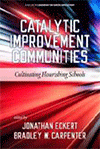
Catalytic Improvement Communities
Cultivating Flourishing Schools
Edited by:
Jonathan Eckert, Baylor University
Bradley W. Carpenter, Sul Ross State University
A volume in the series: Leadership for School Improvement. Editor(s): Khalid Arar, Texas State University.
Published 2024
In chemistry, a catalyst accelerates change without being depleted. As we seek school improvement, we need sustainable, scalable changes, and therefore catalytic structures are ideal. From communities of practice to professional learning communities to Networked Improvement Communities (NICs) much has been made in the scholarly and consultancy literature about collaborative approaches to improvement.
The benefit of improvement communities that operate in networks over professional learning communities or isolated communities of practice is that they allow for broader experimentation, more rapid iteration, and greater possibility for scaling improvement. Educators have many tools and protocols to support the various approaches to improvement, evidenced by the many tools the Carnegie Foundation has developed for NICs alone. However, we need to understand how these are being used in a wide range of contexts and iterations.
This book answers three questions: 1) How can improvement communities act as catalysts? 2) How do improvement communities serve as discipline, creative inquiry? 3) Most importantly, how do improvement communities support flourishing individuals? These three questions serve as the drivers of three sections with practical recommendations and insights for teachers, administrators, and policymakers that will lead to more sustainable leadership practices and thriving educators, students, and communities.
CONTENTS
-
Paperback979-8-88730-522-6
Web price: $45.04 (Reg. 52.99)
-
Hardcover979-8-88730-523-3
Web price: $80.74 (Reg. 94.99)
- eBook979-8-88730-524-0

- EDU032000 - EDUCATION: Leadership
- EDU029010 - EDUCATION: TEACHING METHODS & MATERIALS: Mathematics
- EDU046000 - EDUCATION: Professional Development
-
 Compassionate Leadership for School Improvement and Renewal
Compassionate Leadership for School Improvement and Renewal
-
 Continuous Improvement
A Leadership Process for School Improvement
Continuous Improvement
A Leadership Process for School Improvement
-
 Equity & Access
An Analysis of Educational Leadership Preparation, Policy & Practice
Equity & Access
An Analysis of Educational Leadership Preparation, Policy & Practice
-
 Leadership for School Improvement
Reflection and Renewal
Leadership for School Improvement
Reflection and Renewal
-
 Leveraging Crisis for Equitable School Improvement
Leadership Strategies from the Field
Leveraging Crisis for Equitable School Improvement
Leadership Strategies from the Field
-
 Maximizing the Policy-Relevance of Research for School Improvement
Maximizing the Policy-Relevance of Research for School Improvement
-
 Supporting Leaders for School Improvement Through Self-Care and Wellbeing
Supporting Leaders for School Improvement Through Self-Care and Wellbeing

